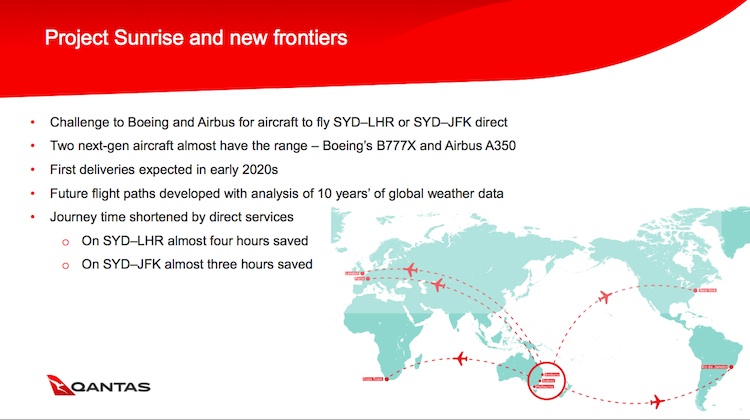Qantas is seeking passenger input for the design of cabin amenities for its proposed Project Sunrise nonstop flights from Australia’s east coast to London and New York.
The airline said on Tuesday it would soon survey its frequent flyers to gauge their opinions on what the airline has termed “the sky is the limit” concepts. These include, but are not limited to:
- A stretch/exercise zone on board;
- A communal bar, dining or self-service café zone;
- A crèche;
- A work and study section including work stations; and
- Converting a number of lavatories into more spacious “change and refresh” stations. (Qantas said weight limitations would likely prevent carrying enough water for showers.)
Qantas head of customer strategy and product development Phil Capps said the airline wanted to revolutionise air travel for passengers on board the aircraft that would eventually operate these proposed ultra long-haul flights.
And Qantas’s frequent flyer members, which number about 12 million, were a key element in developing the right products for these services.
“Our frequent flyers are experts when it comes to spending time in the air so we are keen to tap in to their experience to gauge appetite for a wide variety of possible innovations,” Capps said in a statement.
“It’s still early days and the final cabins may feature some or none of the ideas we’re asking for feedback on, but we want to have the conversation with our customers to help inform our planning.
“We wanted to put all options on the table.
“What sounds unconventional today may well become tomorrow’s new norm. Some ideas are more viable than others but our strategy is to find out what the priorities are for a cross section of travellers.”

Qantas floated some new thinking on passenger amenities in March, shortly after the airline commenced nonstop flights between Perth and London Heathrow with Boeing 787-9 equipment.
Speaking at an aviation club lunch in London, Qantas chief executive Alan Joyce said Project Sunrise was an opportunity for some “out there thinking” on what could be offered to passengers on the proposed 20-hour flights.
“Could some of the freight areas that we may not be able to use be used as an exercise area? Could they be used for berths for people to sleep in? What are the out there ideas that could apply to this and really change air travel for the future,” Joyce said.
“And nothing, nothing is off the table.”
In April, Airbus and Zodiac Aerospace announced they would partner to develop and market passenger berths designed for the cargo deck.
Concept drawings showed four different zones, comprising a conference room, lounge, kids and family area, and medical care zone.
The pair said these modules would be interchangeable with regular cargo containers and would not affect the aircraft’s cargo flow and loading systems.
Meanwhile, Qantas said it had invited global seat manufacturers to come up with concepts for next-generation economy and premium economy seats for these proposed ultra-long-haul flights.
VIDEO: A look at the lower deck modules being developed by Zodiac Aerospace, as shown on the company’s YouTube channel.
Qantas looks to place order for Project Sunrise in 2019
The two aircraft in contention to meet Qantas’s demanding Project Sunrise challenge are Airbus’s A350 platform and Boeing’s 777-X.
Qantas chief executive Alan Joyce told reporters on the sidelines of the International Air Transport Association (IATA) annual general meeting in Sydney in early June the airline hoped to conclude the technical evaluation with Airbus and Boeing, as well as the consultation with regulators, by the end of calendar 2018.
A request for proposal (RFP) would †hen follow, with an order placed in 2019 for delivery in 2022 should the business case stack up.
For now, Qantas’s ambition is to have a high-capacity, multi-class cabin and “zones” for other in-flight activities.
“First and foremost for us, we are now looking at an aircraft configuration that gives us some flexibility and an opportunity for around an over 300-passenger seat count on the aircraft for the economics to be in the right place for us,” Qantas international chief executive Alison Webster told reporters on the sidelines of the IATA AGM.
“We are clearly still moving around through the final numbers on that because we are also looking at a four-cabin configuration of the aircraft design and again as I said these are all still works in progress.”
Boeing said in June it was very close to finalising the design work on the 777-8X, which although yet to reach firm configuration is listed on the company’s website as having a range of 8,700nm and a passenger capacity of 350-375 seats.

Meanwhile, the Airbus A350-900ULR (Ultra Long Range) will be delivered to launch customer Singapore Airlines (SIA) later in 2018 and be deployed on the world’s longest commercial passenger service by distance from October 11 when it is used to operate nonstop between Singapore and New York Newark (8,285nm).
Airbus, which has not published seating data for the the A350-900ULR, has stated that the aircraft was capable of flying more than 20 hours and had a range of up to 9,700nm based on a “typical high premium cabin”.
Further, Airbus chief commercial officer Eric Schulz said at the sidelines of the IATA AGM the airframer could develop a ULR variant for the larger A350-1000.
What do Australian Aviation readers think should be included on aircraft operating ultralong-haul flights? Please add your thoughts in the comments below.
(Read more about Project Sunrise in the July edition of Australian Aviation, now available for digital download at Zinio, Issuu and the Apple app store or at newsstands from June 28.)













